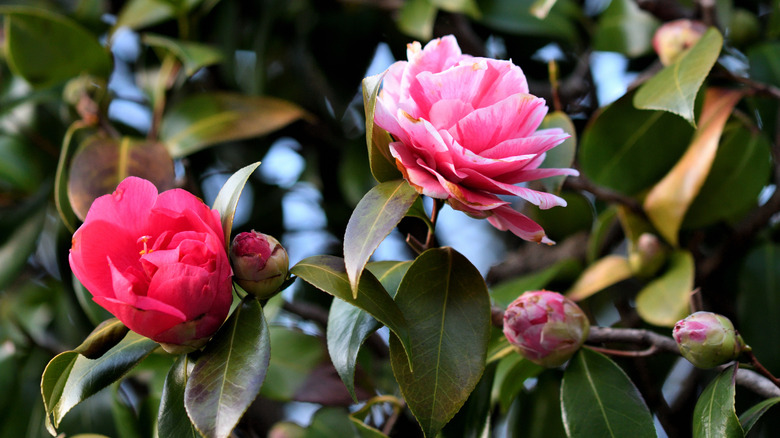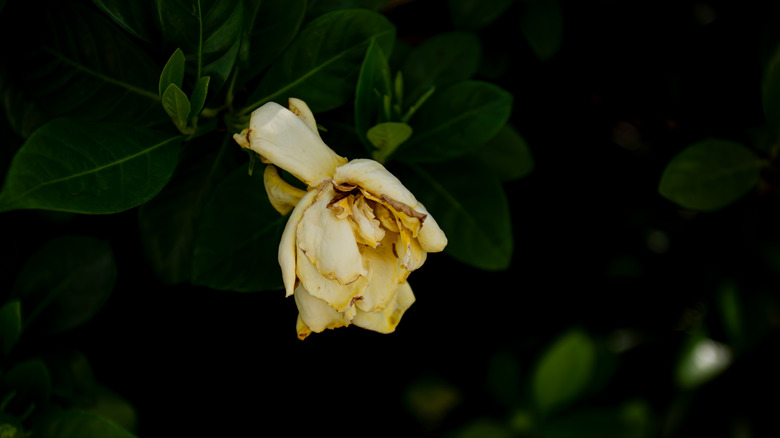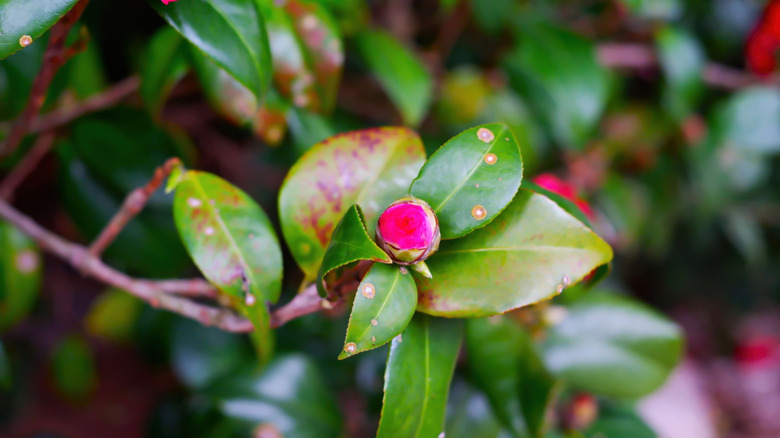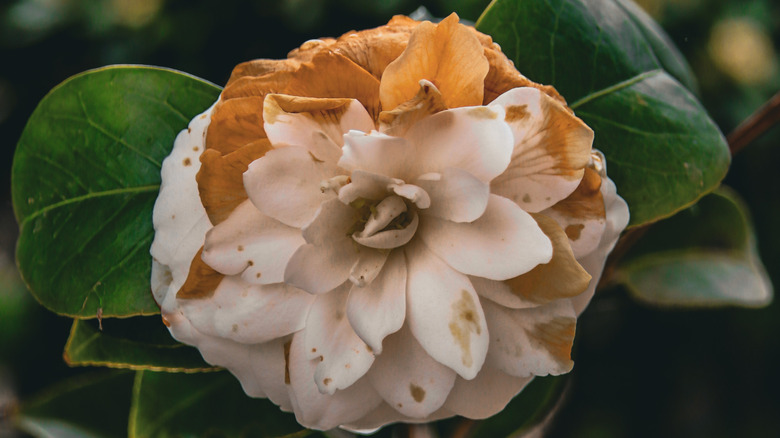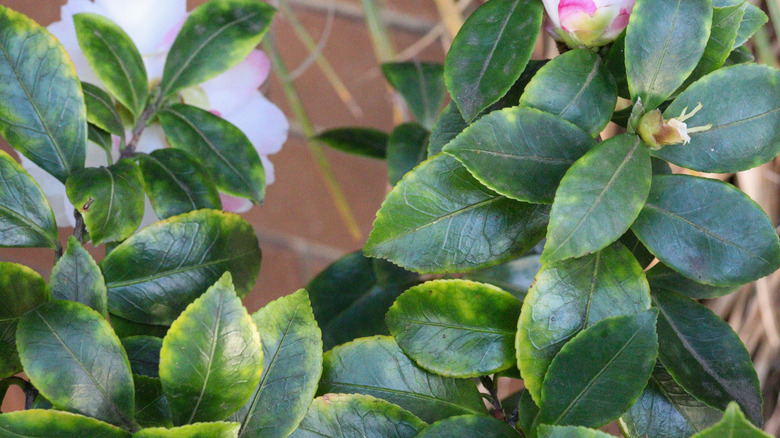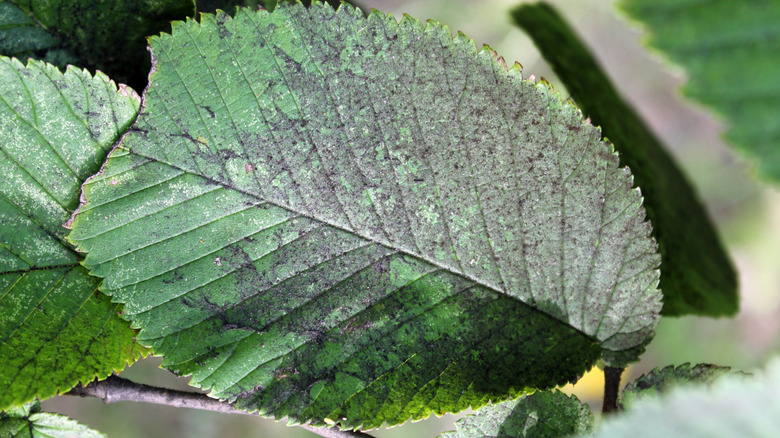Common Diseases To Watch Out For On Camellia Flowers
When you're looking for an easy-to-grow plant that can add color and beauty to your garden, camellias can be a great choice. The plants produce gorgeous flowers and can bloom starting in March. This means that your garden will start displaying gorgeous colors — typically a pink, white, or red color — earlier than many others. Because the plants are evergreens, they also won't lose their leaves during the winter, continuing to add a touch of color all year long.
However, camellias can be affected by several diseases, including camellia dieback, flower blight, and root rot, just to name a few. Depending on the disease that hits your beautiful plant, it can cause a range of damage. The flowers may lose their vibrant color, the leaves may become spotted or start yellowing, and portions of the plants (and, sometimes, even the entire plant) may die. Part of understanding how to grow and take care of camellia plants means learning how to identify the signs of these diseases. You will also want to know what to do to minimize the impact of each disease on your plants — or even to nip them in the bud completely. It can literally be the difference between life and death for your flowers.
Camellia dieback and canker
If there's one camellia disease you'll want to learn how to protect your plants against, it's camellia dieback and canker. This is a fungal disease (caused by Glomerella cingulata) that can kill entire sections of the plant, or even the entire plant if no action is taken. When you look at the infected branches, you'll notice that their leaves have started to wilt and are yellowing. Beyond the sickly-looking leaves, cankers can form on the branches and bark. Anything above the location of these cankers can die, or become very wilted and unhealthy. You're most likely to spot signs of camellia blight when it is warmer outside.
If one of your camellia plants is infected with dieback and canker, then it will be imperative to take action to prevent the disease from spreading to the rest of the camellia flowers in your garden. Knowing the correct way to prune your camellias to remove the dead sections is one key component. After pruning the diseased plant, be sure to disinfect the tools. Otherwise, you may inadvertently spread the disease. Be careful when watering, too. If water splashes off of an infected section of a plant, it can also spread the disease.
To minimize the chances that your camellias will be infected in the first place, prioritize their health. This means paying attention to the watering and fertilization needs, being careful to avoid gashing the leaves or bark (the disease can enter through these cuts), and making sure that the soil you plant them in is acidic and well-drained.
Algal leaf spot
Camellias infected with algal leaf spot are likely to have splotches of greenish-brown to greenish-gray scattered over their leaves (and possibly also branches). These spots are not a clean circle. Rather, the edges are imperfect and slightly bumpy looking. This disease is most commonly found during the summer, as it is caused by a specific type of algae, Cephaleuros virescens, which is more prevalent in hot weather. This algae has the potential to cause serious damage to a plant if it manages to enter beyond the surface, commonly through some sort of gash or opening. In other cases, the spots and colonies of algae causing them may drop off over time or be washed away by water.
Keeping your plants healthy and taking steps to improve airflow can help protect them against algal leaf spot. If you have several camellias planted too closely together, it can create a more favorable growing environment (everything will stay more moist due to lack of airflow). If any plants in your garden are infected, be sure to regularly clean up any dropped or pruned diseased leaves to minimize the spread.
Camellia flower blight
Failing to understand how to prevent camellia petal blight is a mistake you don't want to make when growing camellias. While this disease only impacts the flowers and not other parts of the plant, it can move quickly and seriously damage the beautiful blooms. Within just two days of being infected, the flowers can drop — so you can picture just how quickly this disease, which is caused by the fungus Ciborinia camellia, can ravage your once beautiful plants. Since it only takes two days for the entire flower to drop, you can probably deduce that this disease moves quickly. The first signs of infection are typically small brown splotches on the petals of the flower. However, these few spots will quickly spread and grow, covering practically the entire flower quickly.
Since camellia flower blight is caused by a fungus, preventing it means limiting the spread of this fungus. One key thing you should do is to remove any of the infected flowers — ideally before they drop and spread more of the fungus into the soil. Be sure to sanitize your pruning shears, however, to avoid inadvertently spreading the disease yourself to a healthy flower. If infection is severe, you can consider a chemical treatment, applying it to the base of the plant the following season before it starts flowering.
Root Rot
Root rot is another disease that may threaten your camellia flowers. Also caused by a fungus, Phytophthora cinnamomi, the disease can result in a host of problems for the plants. As you can probably guess based on the name, this disease impacts the roots of the plants. They'll often turn a darker brown color, and cankers may develop towards the base of the stem near the roots. Additionally, the leaves may yellow, the plant may start wilting, and the entire camellia plant may die. Sometimes, this death is quite sudden. Plants that die quickly are typically younger and don't have very developed root systems. Plants that do have a deeply established root system can also be killed by the disease. However, death can occur much more slowly — often over a few years — as it spreads throughout the roots and impacts more of the plant.
The best way to protect your plants against root rot is to take measures to prevent them from getting infected in the first place. One key thing to consider is the soil. Root rot is more likely to occur in soil with poor drainage that keeps the roots too wet. So, amending the soil so that it is well-draining is imperative. Beyond this, it is important to understand that some camellia varieties are more likely to be impacted than others. If you know there has been a problem with root rot in the past, opting to plant Camellia sasanqua, a more resistant variety, can be a good choice.
Sooty mold
Another fungal disease you might want to look out for on your camellia plants is sooty mold. Once you see an infected plant, it becomes quite evident where this disease got its name from — the leaves of the plant look as if they are covered in black soot. However, this black covering is not the ash you would find in your fireplace. Instead, it is the fungus (Atichia glomerulosa). Despite what it looks like, the fungus is actually not growing on the leaf itself. It actually grows on the honeydew that is left behind by aphids and other pests.
Fortunately, sooty mold primarily only impacts the appearance of a camellia plant. In most cases, it doesn't actually threaten the health of the plant or its leaves. In rare cases, when the layer of "soot" covering the leaves is very heavy, it has the potential to prevent photosynthesis from being completed properly.
Because the "soot" forms over the honeydew from aphids and other pests, one of the best ways to prevent this disease from impacting your camellia plants is to focus on controlling the pests. Often, chemical pesticides are not necessary. You can try spraying the bugs with the hose or making your garden more attractive to beneficial predators, such as lacewings or parasitic wasps, to keep infestations under control.
